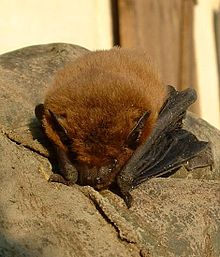Yangochiroptera
| Yangochiroptera | |
|---|---|

| |
| A common pipistrelle, a member of the Yangochiroptera suborder | |
| Scientific classification | |
| Domain: | Eukaryota |
| Kingdom: | Animalia |
| Phylum: | Chordata |
| Class: | Mammalia |
| Order: | Chiroptera |
| Suborder: | Yangochiroptera Koopman, 1984 |
| Families | |
|
See text | |
Yangochiroptera, or Vespertilioniformes, is a suborder of Chiroptera that includes most of the microbat families, except the Rhinopomatidae, Rhinolophidae, Hipposideridae, and Megadermatidae. These other families, plus the megabats, are seen as part of another suborder, the Yinpterochiroptera. All bats in Yangochiroptera use laryngeal echolocation(LE), which involves the use of high-frequency sounds to detect prey and avoid obstacles.[1]
The rationale for the Yangochiroptera taxon is primarily based on molecular genetics data. The Yangochiroptera/ Yinpterochiroptera classification remains a relatively recent proposal, which challenges the traditional view that megabats and microbats form monophyletic groups by claiming that the superfamily Rhinolophoidea is more closely related to Old World fruit bats than other microbats.[2] Further studies are being conducted, using both molecular and morphological cladistic methodology, to assess the merit of this alternative view of bat evolution.[3]
The term "Yangochiroptera" was apparently proposed in 1984 by Karl F. Koopman.[4]
As an alternative to the subordinal names Yinpterochiroptera and Yangochiroptera, some researchers use the terms Pteropodiformes and Vespertilioniformes.[4][5] Under this new proposed nomenclature, Vespertilioniformes is the suborder that would replace Yangochiroptera.
Classification
[edit]Suborder Yangochiroptera (Vespertilioniformes)
- Family Cistugidae (wing-gland bats)
- Superfamily Emballonuroidea
- Family Emballonuridae (sac-winged bats)
- Family Nycteridae (hollow-faced bats)
- Family Furipteridae (smoky bats)
- Family Miniopteridae (bent-winged or long winged bats)
- Family Molossidae (free-tailed bats)
- Family Mormoopidae (ghost-faced bats)
- Family Mystacinidae (New Zealand short-tailed bats)
- Family Myzopodidae (sucker-footed bats)
- Family Natalidae (funnel-eared bats)
- Family Noctilionidae (bulldog bats)
- Family Phyllostomidae (leaf-nosed bats)
- Family Thyropteridae (disk-winged bats)
- Family Vespertilionidae (vesper bats)
References
[edit]- ^ Nojiri, Taro; Wilson, Laura A. B.; López-Aguirre, Camilo; Tu, Vuong Tan; Kuratani, Shigeru; Ito, Kai; Higashiyama, Hiroki; Son, Nguyen Truong; Fukui, Dai; Sadier, Alexa; Sears, Karen E.; Endo, Hideki; Kamihori, Satoshi; Koyabu, Daisuke (2021-04-12). "Embryonic evidence uncovers convergent origins of laryngeal echolocation in bats". Current Biology. 31 (7): 1353–1365.e3. doi:10.1016/j.cub.2020.12.043. hdl:1885/286428. ISSN 0960-9822. PMID 33675700. S2CID 232125726.
- ^ Jones, Gareth; Teeling, Emma C. (2006-03-01). "The evolution of echolocation in bats". Trends in Ecology & Evolution. 21 (3): 149–156. doi:10.1016/j.tree.2006.01.001. ISSN 0169-5347. PMID 16701491.
- ^ "Order Chiroptera bats". animaldiversity.ummz.umich.edu. Retrieved 2007-12-30.
- ^ a b James M. Hutcheon and John A.W. Kirsch (2006). "A moveable face: deconstructing the Microchiroptera and a new classification of extant bats". Acta Chiropterologica. 8: 1–10. doi:10.3161/1733-5329(2006)8[1:AMFDTM]2.0.CO;2. S2CID 85948117.
- ^ Eick; Jacobs, DS; Matthee, CA; et al. (2005). "A Nuclear DNA Phylogenetic Perspective on the Evolution of Echolocation and Historical Biogeography of Extant Bats (Chiroptera)". Molecular Biology and Evolution. 22 (9): 1869–86. doi:10.1093/molbev/msi180. PMID 15930153.
Following the recommendations of Hutcheon and Kirsch (2004), we refer to the two suborders of chiropterans as 'Pteropodiformes' (comprising the Pteropodidae, Rhinolophidae, Hipposideridae, Megadermatidae, and Rhinopomatidae) and 'Vespertilioniformes' (remaining microbat families).
- Teeling, E. C.; Springer, M.; Madsen, O.; Bates, P.; O'Brien, S.; Murphy, W. (2005-01-28). "A Molecular Phylogeny for Bats Illuminates Biogeography and the Fossil Record". Science. 307 (5709): 580–584. Bibcode:2005Sci...307..580T. doi:10.1126/science.1105113. PMID 15681385. S2CID 25912333.
- Stanhope, M. J.; Teeling, E. C.; Scally, M.; Kao, D. J.; Romagnoli, M. L.; Springer, M. S. (2000-01-13). "Molecular evidence regarding the origin of echolocation and flight in bats". Nature. 403 (6766): 188–192. Bibcode:2000Natur.403..188T. doi:10.1038/35003188. PMID 10646602. S2CID 205004782.
